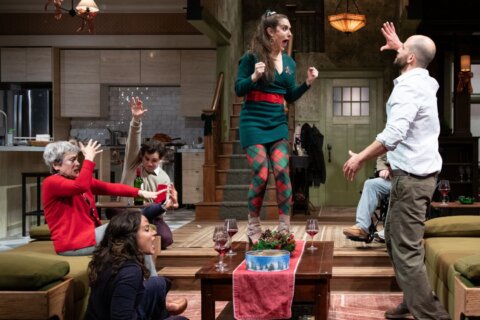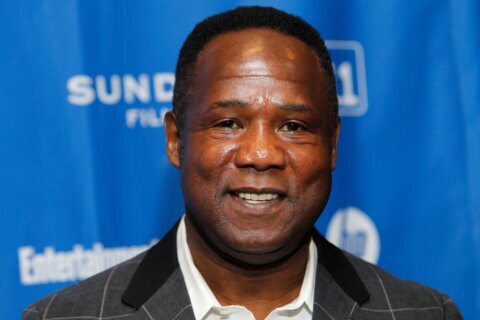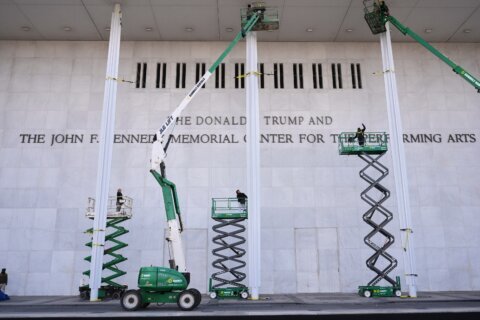Next year marks the 20th anniversary of the D.C. sniper attacks of 2002.
The harrowing days are chronicled in the new documentary TV series “I, Sniper.”
“No one’s ever tried to do something this ambitious,” Creative Director John Smithson told WTOP. “There were three prongs to this: the families of the 10 known victims and those who survived … a huge number of law enforcement [for] the biggest manhunt in American history [and] getting phone calls with Lee Malvo from jail.”
Episode 1 is available online, while Episode 2 airs on VICE TV on Monday at 10 p.m.
“It starts with the first killing over in Washington State, then sets up the backstory of these two people, Lee Malvo and John Muhammad, what brought them together, their grievances, starting to train for these attacks,” Smithson said.
“Episode 2 will bring us to D.C., so you see in tonight’s episode how the story begins to unfold in the Washington, D.C. area,” Producer Mary-Jane Mitchell told WTOP.
After the initial killing in Tacoma, Washington, in February 2002, the first attack in the D.C. area occurred in Clinton, Maryland, when Paul LaRuffa was shot outside of his Italian restaurant where the gunmen stole his laptop and briefcase containing $3,500.
“I left on a Thursday night, Sept. 5, 2002, like I had thousands of times,” LaRuffa told WTOP. “The window next to my head on the driver’s side exploded with the first shot, then there were four more shots. All five hit me. … Your life can change in seconds.”
He managed to survive and watched the D.C. sniper attacks unfold like the rest of America, only finding out that he was linked when his laptop was found in the suspects’ vehicle when they were caught at a rest stop in Myersville, Maryland, in October.
“The week I spent in the hospital and every day after, I had flashbacks,” LaRuffa said. “I heard that first shot, I felt that glass breaking all over me and I relived that over and over again. It was hell. … After they were caught, I didn’t have flashbacks anymore.”
In addition to survivors like La Ruffa, we also see interviews with law enforcement.
“Law enforcement are also citizens, so they had their own concerns about their families at the same time trying to investigate,” Mitchell said. “It was incumbent on them to follow every lead. The white box truck [false lead] took on a world of its own.”
Muhammad was executed in 2009, while Malvo serves out his sentence at Red Onion State Prison in Virginia, featured in recorded phone calls in the documentary.
“He poses the question: What inside me made that possible?” Mitchell said. “He wrestled one 15-minute phone call at a time with trying to find an answer to that. My job was to push him beyond what he did and examine why he did it. … I think there is value in understanding why a 17-year-old would commit mass murder.”
LaRuffa says the series is “well done, because it stirs emotion.”
“The way I feel today is vastly different from the way I felt in 2002,” LaRuffa said. “Did I hate him and what he did? Yeah, I did. … I’m always asked, ‘Do you forgive him?’ It’s easy to confuse forgiveness with excusing the actions, but forgiveness, the definition I use, is letting go of the anger toward a person. … And I’ve done that.”
Along the way, his opinion has evolved on life sentences for juveniles.
“I’ve come to the conclusion that it’s not justice,” LaRuffa said. “I became active in Maryland, particularly in testifying for a law that says a juvenile who’s committed murder, you can’t sentence them to life without parole. After 20 years of incarceration, they get a chance for a review.”
Regardless of criminal rehabilitation, the lives of the families are forever broken.
Here is a list of the victims of the shooting spree:
- Keenya Cook in Tacoma, Washington
- Jerry Ray Taylor in Tucson, Arizona
- Paul LaRuffa in Clinton, Maryland
- Rupinder Oberoi in Silver Spring, Maryland
- Muhammad Rashid in Brandywine, Maryland
- Million Woldemariam in Atlanta, Georgia
- Claudine Parker & Kellie Adams in Montgomery, Alabama
- Hong Ballenger in Baton Rouge, Louisiana
- James Martin in Wheaton, Maryland
- Sonny Buchanan in White Flint, Maryland
- Prem Kumar Walekar in Aspen Hill, Maryland
- Sarah Ramos in Silver Spring, Maryland
- Lori Rivera in Kensington, Maryland
- Pascal Charlot in Washington D.C.
- Caroline Seawell in Fredericksburg, Virginia
- Iran Brown in Bowie, Maryland
- Dean Meyers in Manassas, Virginia
- Kenneth Bridges in Massaponax, Virginia
- Linda Franklin in Falls Church, Virginia
- Jeffrey Hopper in Ashland, Virginia
- Conrad Johnson in Aspen Hill, Maryland
The murders were reported live on WTOP, which you’ll hear in the documentary.
“We used extensively the sound archive, including from your radio station, to bring you back to that period and the level of fear and tension,” Smithson said.
“At the time, I was working on a different project in D.C. like everyone utterly relying on WTOP, so I feel a huge debt of gratitude to the radio station,” Mitchell said.
Listen to our full conversation here.








